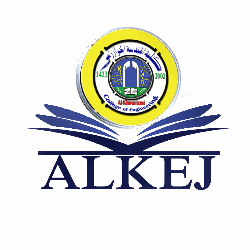Study the Effect of Carbon Fiber Volume Fraction and their Orientations on the Thermal Conductivity of the Polymer Composite Materials.
Abstract
The effect of fiber volume fraction of the carbon fiber on the thermal conductivity of the polymer composite material was studied. Different percentages of carbon fibers were used (5%, 10%, 15%, 20%, and 25%). Specimens were made in two groups for unsaturated polyester as a matrix and carbon fibers, first group has parallel arrangement of fibers and the second group has perpendicular arrangement of fibers on the thermal flow, Lee's disk method was used for testing the specimens. This study showed that the values of the of thermal conductivity of the specimens when the fibers arranged in parallel direction was higher than that when the fibers arranged in the perpendicular direction
The results indicated that the thermal conductivity increases with the increasing the fiber volume fraction. Minimum value was (0.64 W/m.°C) for parallel arrangement and (0.1715 W/m.°C) for perpendicular arrangement at (Vf = 5%) .Maximum value for parallel and perpendicular were (2.65 W/m. °C) and (0.215 W/m.°C) at (Vf = 25%) respectively.
Downloads
References
[2-] BSR Murthy, Dr. A. Rama Krishna and B.V Rama Krishna,” Thermal Analysis of Epoxy Based Fiber-Reinforced”, IE(I) Journal – MC, Vol.84,April, (2004).
[3-] M.W. Gaglord, “Reinforced Plastic; Theory and Practice “,2nd edition, Chahnenrs Put. Co. Inc., (1974).
[4-] Charles A Sorrell, “Advanced Nanoporous Composite Materials for Industrial Heating Applications”, Applied Sciences Laboratory, Inc., http://www.eere.energy.gov/industry/imf/pdfs/ibni.composite. pdf., (2002)
[5-] B.W. James and P. Harrison,” Analysis of the Temperature Distribution, Heat Flow and Effective Thermal Conductivity of Homogenous Composite Materials with Anisotropic Thermal Conductivity”, Journal of Physics, Vol.D, Applied Physics, issue 9, sept. (1992).
[6-] Zhan – Sheng Guo, Shanyi Du and Boming Zhang, “Temperature Distribution of the Thick Thermoset Composite”, Journal of Modeling and Simulation in Materials Science and Engineering, Volume 12, issue 3, (China) may, (2004).
[7-] F. Rondeaux, Ph. Bready and J.M. Rey, “Thermal Conductivity Measurements of Epoxy Systems at Low Temperature”, Cryogenic Engineering Conference (CEC), (USA), July (2001).
[8-] Lamees A. Khalaf, "Studying the mechanical and physical properties for unsaturated polyester reinforced by fiber glass and nylon fiber
composites", M.Sc. Thesis, University of Technology, Materials Engineering Department (2006).
[9-] Saad M. Elie, "studied the mechanical properties and thermal conductivity for polymer composite material reinforced by aluminum and aluminum oxide particles", M.Sc. Thesis, University of Technology, Materials Engineering Department (2007) .
[10-] R.M. Jones,” Mechanics of Composite Materials”, McGraw-Hill, New York, (1975).
[11-] W. Bolton,” Engineering Materials Technology”, Butterworth – Heinemann, Third edition, (1998).
[12-] William D. Callister,” Materials Science and Engineering An Introduction”, Sixth Edition, John Wiley and Sons, Inc., (2003).
Downloads
Published
Issue
Section
License
Copyright: Open Access authors retain the copyrights of their papers, and all open access articles are distributed under the terms of the Creative Commons Attribution License, which permits unrestricted use, distribution and reproduction in any medium, provided that the original work is properly cited. The use of general descriptive names, trade names, trademarks, and so forth in this publication, even if not specifically identified, does not imply that these names are not protected by the relevant laws and regulations. While the advice and information in this journal are believed to be true and accurate on the date of its going to press, neither the authors, the editors, nor the publisher can accept any legal responsibility for any errors or omissions that may be made. The publisher makes no warranty, express or implied, with respect to the material contained herein.








